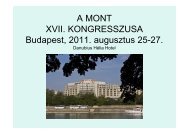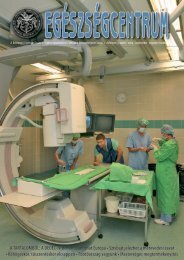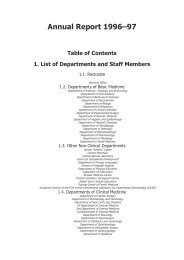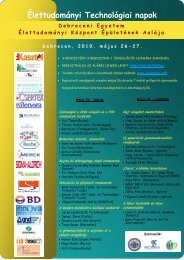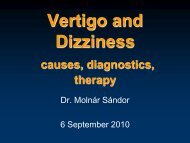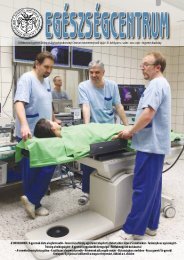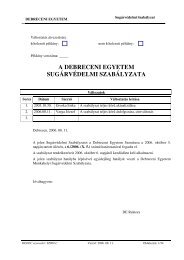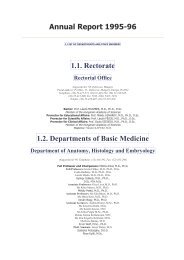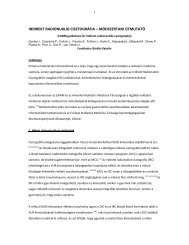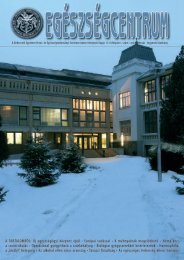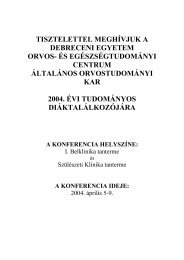- Page 4 and 5:
A KONFERENCIA PROGRAMJAMegnyitó: 2
- Page 6 and 7:
A SZEKCIÓK RÖVID PROGRAMJAB1. Sze
- Page 8 and 9:
K1. Szekció február 16., szerda,
- Page 10 and 11:
P5. Szekció február 21., hétfő,
- Page 13 and 14:
RÉSZLETES PROGRAM13
- Page 15 and 16:
Bírálati szempontok a TDK előad
- Page 17:
Szekció elnökökFebruár 14.,Hét
- Page 20 and 21:
Biokémiai, molekuláris biológiaF
- Page 22 and 23:
B2. Szekció február 14., hétfő,
- Page 24 and 25:
Operatív orvostudomány,diagnoszti
- Page 26 and 27:
O2. Szekció február 14., hétfő,
- Page 28 and 29:
Morfológia-patomorfológia,cellul
- Page 30 and 31:
M2. Szekció február 15., kedd, 16
- Page 32 and 33:
Epidemiológia, preventív medicina
- Page 34 and 35:
E2. Szekció február 14., hétfő,
- Page 36 and 37:
Konzervatív orvostudományFebruár
- Page 38 and 39:
K2. Szekció február 16., szerda,
- Page 40 and 41:
Élettan, kórélettan, farmakológ
- Page 42 and 43:
ÉF2. Szekció február 16., szerda
- Page 44 and 45:
PhD SzekciókFebruár 17., csütör
- Page 46 and 47:
P2. Szekció február 5., hétfő,
- Page 48 and 49:
PhD SzekciókFebruár 18, péntekP3
- Page 50 and 51:
P4. Szekció február 18., péntek,
- Page 52 and 53:
PhD SzekciókFebruár 21, hétfőP5
- Page 54 and 55:
P6. Szekció február 21., hétfő,
- Page 56 and 57:
PhD SzekciókFebruár 22, keddP7, P
- Page 58 and 59:
P8. Szekció február 22., kedd, 15
- Page 61 and 62:
Ph. D.ELŐADÁS-KIVONATOK61
- Page 63 and 64:
Almássy János, Ph.D. IÉlettani I
- Page 65 and 66:
Barok Márk, Ph.D. IIIDE OEC Biofiz
- Page 67 and 68:
Bárdi Edit Dr., Ph.D. VDEOEC Gyerm
- Page 69 and 70:
Buslig Júlia Judit, Ph.D. IDEOEC B
- Page 71 and 72:
Dér Henrietta Dr., Ph.D. IDE OEC I
- Page 73 and 74:
Erdei Nóra Dr., Ph.D. IDE OEC Kard
- Page 75 and 76:
Erdős Erika, Ph.D. IIIDE OEC Immun
- Page 77 and 78:
Griger Zoltán, Ph.D. IIDE OEC Éle
- Page 79 and 80: Hegedüs Éva, Ph.D. IIBiofizikai
- Page 81 and 82: Horváth Péter, Ph.D. IIIDE OEC Fa
- Page 83 and 84: Juhász Judit, Ph.D. IIBiofizikai
- Page 85 and 86: Kapitány Anikó, Ph.D. IIDEOEC III
- Page 87 and 88: Kiss Andrea, Ph.D. IIOrvosi Vegytan
- Page 89 and 90: Leny Andrij Dr., Ph.D. IIDebreceni
- Page 91 and 92: Lontay Beáta, Ph.D. IIIDE-OEC Orvo
- Page 93 and 94: Makkai Boglárka, Ph.D. IIINeuroló
- Page 95 and 96: Májai Gyöngyi Dr., Ph.D. IIBioké
- Page 97 and 98: Mezey Géza Dr., Ph.D. IIIFarmakol
- Page 99 and 100: Molnár Andrea Dr., Ph.D. IIDE OEC
- Page 101 and 102: Orosz Ágnes Dr., Ph.D. IIDE OEC BI
- Page 103 and 104: Pályi Krekk Zsuzsanna, Ph.D. IIIDE
- Page 105 and 106: Póliska Szilárd, Ph.D. IDEOEC Bio
- Page 107 and 108: Shlomit Mendelbaum, Ph.D. IUniversi
- Page 109 and 110: Szarvas Mariann, Ph.D. III, Friedl
- Page 111 and 112: Szegedi István Dr., Ph.D. levelez
- Page 113 and 114: Széles Lajos, Ph.D. IIDE-OEC, Biok
- Page 115 and 116: Szilvási Henrietta, Ph.D. IIDE OEC
- Page 117 and 118: Tar Krisztina, Ph.D. IVDE OEC Orvos
- Page 119 and 120: Tóth Beáta, Ph.D. III, Sarang Zso
- Page 121 and 122: Tóth István Balázs, Ph.D. IIDE O
- Page 123 and 124: Törőcsik Dániel Dr., Ph.D. IIDE
- Page 125 and 126: Ujlaky-Nagy László Dr., Ph.D. III
- Page 127 and 128: Varga Orsolya Dr., Ph.D. IIMagatart
- Page 129: Végh Judit Dr., Ph.D. IIDE OEC III
- Page 133 and 134: Barati Edina, ÁOK V, Váradi Zita,
- Page 135 and 136: Battyányi Veronika, ÁOK VDEOEC T
- Page 137 and 138: Bende Marianna, ÁOK V, Bodó Tíme
- Page 139 and 140: Benyó Mátyás, ÁOK VDEOEC, Urol
- Page 141 and 142: Bódi Tibor, TTK V, Feiszt Péter,
- Page 143 and 144: Bogárdi Zsuzsa, ÁOK VDE-OEC Anesz
- Page 145 and 146: Borbíró István, Mol.Biol. VOrvos
- Page 147 and 148: Brázda Péter, TTK VDE OEC, Bioké
- Page 149 and 150: Buzder Tímea, Mol.Biol. V, Gregus
- Page 151 and 152: Csavajda István, ÁOK VIDEOEC III.
- Page 153 and 154: Dajnoki Angéla, Mol.Biol. V, Nyest
- Page 155 and 156: Dezső Flóra, ÁOK VSzemklinika é
- Page 157 and 158: Docsa Marianna, GyTK VGyógyszerhat
- Page 159 and 160: Elek Attila, ÁOK VIMagatartástudo
- Page 161 and 162: Fábián Ákos, ÁOK VDEOEC, Biofiz
- Page 163 and 164: Feiszt Péter, TTK V, Bódi Tibor,
- Page 165 and 166: Frank Máté, Mol.Biol. IV, Jenes
- Page 167 and 168: G. Kiss Orsolya, ÁOK VI, Kromplák
- Page 169 and 170: Girus Ivett, ÁOK VIPszichiátriai
- Page 171 and 172: Gyöngyösi Adrienn , TTK VDE OEC
- Page 173 and 174: Hegedűs Julianna, TTK V, Feiszt P
- Page 175 and 176: Herr György, ÁOK VIDEOEC Urológi
- Page 177 and 178: Illés Krisztina, ÁOK IVDEOEC III.
- Page 179 and 180: Jenes Ágnes, ÁOK VIDEOEC Onkológ
- Page 181 and 182:
Juhász Tamás, TTK VDE OEC Anatóm
- Page 183 and 184:
Kis Andrea, Mol.Biol. VOrvosi Mikro
- Page 185 and 186:
Kiss Ferenc, ÁOK IVII. Sebészeti
- Page 187 and 188:
Kollár Sándor, ÁOK VI, Popity No
- Page 189 and 190:
Koncsos Péter, ÁOK IV, Varga Éva
- Page 191 and 192:
Kovács Dávid, ÁOK IV, Kiss Edina
- Page 193 and 194:
Kozma Bence, ÁOK VDE OEC Szülész
- Page 195 and 196:
Kulcsár István, ÁOK IVDE-OEC, Be
- Page 197 and 198:
Lakatos Andrea, Mol.Biol. IIIDE OEC
- Page 199 and 200:
Lengyel Edit, ÁOK VGyermekklinikaA
- Page 201 and 202:
Markó Zoltán Lóránt, ÁOK VIDEO
- Page 203 and 204:
Nagy Bence, ÁOK IVPathologiai Int
- Page 205 and 206:
Nagy Éva , TTK IVDE OEC III. sz. B
- Page 207 and 208:
Nagy Nikolett, ÁOK VDE OEC Népeg
- Page 209 and 210:
Nyeste Katalin, ÁOK IV, Dajnoki An
- Page 211 and 212:
Pálóczi Balázs, ÁOK VDE OEC, Kl
- Page 213 and 214:
Pap Pál, Mol.Biol. IVÉlettani Int
- Page 215 and 216:
Péterfai Dávid, ÁOK VIDEOEC Szü
- Page 217 and 218:
Petrovszki Enikő, TTK VDEOEC Immun
- Page 219 and 220:
Pucsok Klára, ÁOK VIRuprecht-Karl
- Page 221 and 222:
Radványi Mónika, ÁOK IVDE OEC Be
- Page 223 and 224:
Ruzsnavszky Olga, ÁOK IIIDE OEC É
- Page 225 and 226:
Sajtos Erika, ÁOK IVJósa András
- Page 227 and 228:
Sira Gábor Tihamér, ÁOK VI, Fűz
- Page 229 and 230:
Szánthó Eszter, ÁOK VDE OEC I. s
- Page 231 and 232:
Szeverényi Ivonn, ÁOK VIDEOEC I.s
- Page 233 and 234:
Szilágyi Anna, ÁOK IVDEOEC III.sz
- Page 235 and 236:
Sztancsik Tamás , FOK V, Czene Jud
- Page 237 and 238:
Talián Tímea, ÁOK VDEOEC Neurol
- Page 239 and 240:
Tomcsa Gabriella, ÁOK VBelgyógyá
- Page 241 and 242:
Tóth Eszter Viktória, ÁOK VIBőr
- Page 243 and 244:
Tóth Kornélia , TTK VDE OEC ÁOK
- Page 245 and 246:
Ungvári Erika, Mol.Biol. VDE OEC,
- Page 247 and 248:
Vizkeleti Laura, Mol.Biol. IIINépe



